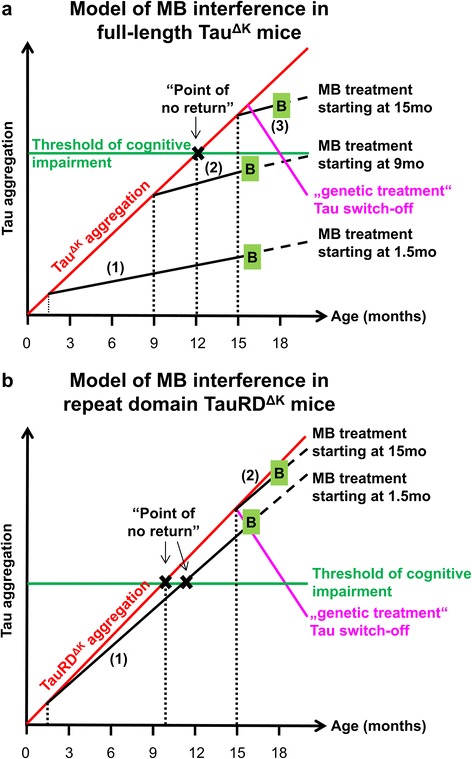Figure 11.

Models of MB interference during disease progression in full-length TauΔK and repeat domain TauRDΔK mice. (a) In TauΔK mice unaltered Tau aggregation due to continuous expression and accumulation of toxic Tau reaches the threshold of cognitive impairment at the age of ~12mo. Once the “point of no return” is passed, TauΔK mice exhibit cognitive impairments and synaptic decay [15]. Preventive application of MB, starting before the critical threshold is reached, efficiently interferes with TauΔK aggregation. Thus, the disease progression is slowed down and the onset of cognitive decline postponed. However, therapeutic MB application initiated at 15mo of age, beyond the “point of no return” and after the onset of cognitive impairment, is not able to rescue the cognitive phenotype. By contrast, “genetic treatment” by TauΔK switch-off can reduce aggregation and reverse the cognitive decline. (b) TauRDΔK exhibits stronger aggregation properties than TauΔK, due to a higher β-propensity. Thus, TauRDΔK mice show a faster disease progression with onset of cognitive decline ~10mo of age [14]. MB’s anti-aggregation properties are not strong enough to efficiently retard the aggregation process, even if applied at early age (1.5mo). Consequently, the “point of no return” is barely delayed in TauRDΔK mice, and therapeutic treatment is ineffective. Similar to TauΔK, genetic treatment by TauRDΔK switch off is still able to reverse the cognitive phenotype even after onset of cognitive impairment. Red line: unaltered progression of Tau aggregation; green line: threshold of cognitive impairment; black X: “point of no return”; solid black lines: MB treatment periods of mice; magenta lines: “genetic treatment” by switch off of Tau expression; B, green boxes: behavior tests and termination of experiments; dotted black lines: assumed further progression of Tau aggregation; (1, 2, 3): MB treatment protocols according to Figure 1; mo: months.
